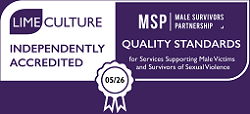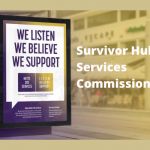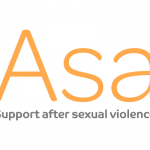CPS Consultation – Our Response
The Crown Prosecution Service (CPS) recently ran a public consultation on changes to the rape and sexual offences legal guidance for prosecutors.
We were able to take part in an online meeting with the CPS as part of our ongoing partnership work with the Consent Coalition. We also sent in a written response which can be found below.
We are very pleased that the CPS is updating its guidance as part of its 5-year RASSO (rape and serious sexual offences) plan. The CPS has taken time to look at many features that might wrongly affect a charging decision which includes rape myths. They also look at case building and at issues that are relevant to certain groups of people, eg LGBT and disabled people/those with disabilities.
We know that the CPS have been working to their updated guidance while waiting for this feedback. This shows a real commitment to improving outcomes for survivors of sexual offences. We hope that these comments are taken on board and people feel more able to seek justice following an incident of sexual violence or abuse.
Details of the consultation can be found here: https://www.cps.gov.uk/consultation/consultation-rape-and-sexual-offences-legal-guidance
Our response is below.
Question 1
Do you think that the new guidance in ‘Chapter 2: Applying the Code for Crown Prosecutors to Rape and Serious Sexual Offences’ in relation to the principles to consider when applying the evidential test will assist prosecutors in arriving at Code compliant charging decisions in RASSO cases?
- The key principles are clear
- This will assist prosecutors if prosecutors read and refer to the guidance
- Survivors will have access to this document, therefore consideration of language may be required, as it can be hard to understand and also triggering. However, we are conscious that this is a professional document
- Will there be a separate policy statement?
- The toolkit is comprehensive
- We welcome the inclusion and/or consideration of: one word against another being enough to bring a case, a Sexual Risk Order in a case with a NFA outcome, information on the impact of trauma made available for juries and information on rape myths and stereotypes made available for juries
Question 2
Is the new content in ‘Chapter 2: Applying the Code for Crown Prosecutors to Rape and Serious Sexual Offences’ around the impact of trauma including the linked online trauma training video accurate and comprehensive?
- This is comprehensive, accurate and informative
- The video content was relevant, easy to watch, although could have been more detail in relation to spotting signs, and that not everyone who experiences CPTSD shows signs of trauma
- A note that should be included is that some signs can present as e.g. laughing or aggression, this can be misinterpreted by the jury
- This is a good level of guidance for CPS, however will the judiciary have access to this information, Inc. Police and defence?
- The impact of trauma information is very informative, well written and comprehensive. The training video is accurate and comprehensive in presenting how victims of sexual violence may present when making statements in court and why these experiences may be triggering
Question 3
Will the updated content within chapter 3 covering reasonable lines of enquiry and disclosure covered at Sections D, E and F assist prosecutors with balancing the needs of the investigation and the right to privacy?
- We could not locate sections D, E and F
- The sections that we could read appeared clear, with good prompts
- This needs to also have Police involvement to be useful
- We feel that this provides confidence for prosecutors
Question 4
Is the revised content on ‘rape myths and stereotypes’ accurate and comprehensive and do you think it will assist prosecutors in making decisions which are not clouded by myths or stereotypes?
(In our response, what the CPS has written is in this font. We have tried to keep our responses in line with the CPS headings where we possible)
Silence does not amount to consent
‘The Court of Appeal has repeatedly stated that there is no evidential obligation for a victim to have said or done anything in order for a guilty verdict to be returned. Judges provide standard directions to the effect that juries are to set aside any stereotypical assumptions about how victims and assailants act and react.’
This is a confusing way of wording it – it almost seems like the onus is being put on the complainant to say something to stop it. Which is not true. The wording does not actually address or confirm the fact in plain English that ‘even if the complainant remained silent or put up no resistance to the sexual activity this does not equal consent
A lot of the information on ‘other’ rape myths (e.g. what a person was wearing) is in linked documents. This is okay, but there is a tendency to lose things within documents. This should have its own listing under this section on the guidance so that it can be found and referred to more easily. It would be useful to have a basic outline of myths and stereotypes in written out in your main document. This is taken from one of your linked documents.
Addressing myths and stereotypes:
- The form of dress a person wears does not mean they should expect to be raped.
- The majority of rape cases are where the offender and complainant know each other.
- Trauma can affect memory and create inconsistency.
- Being drunk makes the complainant vulnerable. It does not mean they were ‘asking for it’;
- Most victims do not fight; resistance and self-protection/defence can be through dissociation, freezing or trying to befriend the defendant – in fact any effort to prevent, stop or limit the event. It does not have to succeed to be an ‘effort’.
- Late reporting may be due to inability to cope with the trauma of the incident, fear of repercussions, maturity with age recognising the abuse, control of the complainant, fear of going to court.
- In cases of adult survivors of child abuse the complainant may regress and behave or speak as a child.
Photographs and communication data is carefully analysed in the context of a rape allegation
A lot of this section is good. However, We think you ought to also mention that, during a period where the complainant is trying to understand what happened, keep things safe or normal, or even explain it away (particularly in cases where the complainant is in a relationship with the accused) they may outwardly still show aspects of still being loving, affectionate or caring towards their attacker. There is probably a statistic or something you could use here to demonstrate this. You have done this better in your section on things on different groups of people relating in particular to the DV section – you could include a sentence of that here.
An acquittal does not automatically mean there was a false allegation
The wording here feeds into rape myths. It should read ‘An acquittal does not mean there was a false allegation.’ By using including the word ‘automatically’ this suggests that there could be. Who is on trial here? The decision that a jury finds a person ‘not guilty’ does not mean that the complainant was lying, it just means that the jury couldn’t find enough to convict against all reasonable double. You wouldn’t put the title with the word ‘automatically’ ahead of a person being acquitted in a murder trial – a person has been murdered. If it is believed that a complainant has been raped and that is enough to get the case to court, then the question of a false allegation and words such as ‘automatically’ which suggest this to be the case do not belong here or in this context.
Victims react in many different ways to a sexual assault
The main reactions be listed here for the benefit of the reader.
It may take time for a rape victim to come forward and report
The trauma of rape can cause feelings of shame and guilt which might inhibit a victim from making a complaint. This fact was recognised by the Court of Appeal in [R v D (JA) October 24 2008] where it was held that judges are entitled to direct juries that due to shame and shock, victims of rape might not complain for some time, and that a late complaint does not necessarily mean that it is a false complaint.
The use of the word ‘necessarily’ feeds into rape myths as it suggests that a late complaint could mean that it is false and it raising unfair questions about the complainant. It should read ‘a late complaint does not mean that it is a false complaint.
The CPS treats female and male victims of sexual violence equally
We are committed to securing justice for all victims. All our VAWG policies are applied fairly and equitably to all perpetrators and victims of crime – irrespective of their gender. In 2019-20 there were 2,249 female victims of rape, 415 male victims and the gender was not recorded for 517 victims. In recognition that male victims may not come forward to report rape and other VAWG crimes, CPS published a public statement on support for male victims in September 2017.
By listing this section after the paragraph about Volume of Violence against Women and Girls cases you are suggesting in your layout that VAWG is seen as the main issue, ahead of acknowledging that this also happens to men. The general statement on treating female and male victims equally should come ahead of the separate gender issue that is VAWG. Also you need to list LGBTQIA here as well and link to your statement and information for these survivors. By not giving them a mention here you are again going against equality.
You also need to include in this section about acknowledging that the violence, myths and stereotypes perpetrated against survivors of different genders varies and that the CPS is aware and responsive to these.
There needs to be a section on complainants with disabilities.
Where is the information for complainants who are from BAME communities or have strong faith beliefs? What about FGM, forced marriage and the crossover with sexual violence here?
CPS Complainant Data
In the complainant data you list details around the complainants age and gender. In the defendant’s data you list details around the complainants age and gender and ethnicity. Why does the defendant’s ethnicity matter but not the complainants? You are leaving yourselves open to accusations of institutional racism. We recommend providing the same data sets for both complainants and defendants or providing a very good reason why you have not done so.
Question 5
Does the revised content adequately cover the development of rape myths in the digital age?
It was very difficult to find anything that related to this in the guidance and we would suggest that a section specifically under this heading and addressing these myths is created. Details should be given about the situations in which this might occur – so examples of sexual abuse and how it is facilitated by the digital age and how a person might be affected by it. You might also need to link this to legislation that you might already have around this that might not necessarily come under the RASSO remit – e.g. voyeurism for example where people have been ‘upskirted’ and their images shared online.
Details need to be given around the type of rape myths that are happening and the type of offences that are occurring because of the digital age.
Eg:
- That people shouldn’t share their photos online. A person is entitled to share their photos with another consenting adult and put restrictions on what can be done with this.
- That it is their fault that their photos were shared because they consented to an intimate video being taken. Again, photos or videos can only be shared with consent.
- That a person who has been filmed or photographed without their knowledge is to blame for their bad judgment. This is not true – a person should be able to trust who they are intimate with and the responsibility for betraying that trust lies with the perpetrator.
- People should not have met ‘x’ because they met them online. Who is at fault here the perpetrator for lying or the person who trusted the other person?
- If a person meets for a ‘hook-up’ they are automatically agreeing to have sex or have consented to all sexual activity. This is untrue. Despite the fact that some apps are typically seen primarily for casual meets, this does not remove the need for consent or deny a person’s ability to restrict, withhold or remove consent.
- It is only the internet. The fact that a person has/or has been threatened with having photos shared or has been stalked online affects the way that the victim may live their life and the choices they make. This can have a long-term impact and incidents of digital abuse can acutely affect an individual.
- It is driven by passion not abuse. This is wrong. A person who chooses to share photos, stalk, threaten or use the digital world to abuse or bring about fear does so while ignoring the feelings and rights of the other person.
- That abusers need tech skills to abuse others online. This is wrong. If a person is able to access social media, they have all the skills needed to abuse someone online.
- The abuse only occurs in heterosexual/romantic relationships. The abuse can happen between anyone, including LGBT, and strangers
You should list some of the issues that are more apparent because of digital age: e.g. so called ‘revenge porn’, sextortion – threatening to share your intimate photos if a person doesn’t…, sexting – sending of intimate photos ‘dick pics’ etc. without getting permission, use of threat and coercion unless an intimate photo is shared.
Question 6
Does the revised content clearly highlight the tools available to prosecutors and advocates when challenging rape myths?
- Consideration should be given to the inclusion of more detail around special measures
- Education of juries in relation to rape myths
- Comprehensive use of tools
Any information that is given is lost in the body of the text. These tools should be identified with further details given under a specific heading – e.g. tools available to prosecutors and advocates when challenging rape myths.
Question 7
Is the content covering ‘pre-existing mental illness and potential psychological reactions to sexual abuse’ including the linked ‘psychological evidence toolkit for prosecutors’ accurate and comprehensive?
The pre-existing mental illness and potential psychological reactions to sexual abuse section contains a number of concerns, as per below:
- The use of language is misleading, with generalisations. The suggestions that the majority of sexual abuse survivors being over their abuse in 3-4 months is misleading; as there are no numbers given for ‘majority’ leaving this open to interpretation. The timescale of 3-4 months is also misleading and we would welcome conclusive imperial studies that back up these findings.
- The descriptive use of ‘mental retardation’ and ‘mental handicap’ is poorly executed and at the very least offensive
Question 8
Is the content of the ‘same sex sexual violence toolkit’ accurate and comprehensive?
(In our response, what the CPS has written is in this font. We have tried to keep our responses in line with the CPS headings where we possible)
When talking about same sex issues, you need to at least, in the introductory passage include the listing of ‘persons of the same sex, trans, non-binary or intersex’
Coming Out
“Coming out” refers to the process by which an individual accepts their own sexual orientation or gender identity; and then makes it known or allows it to be known by others. Coming out is not a “one-off” process. LGBT individuals are constantly making decisions as to whether or not to counter the assumption that they are heterosexual, and have to make this decision in every encounter with people who do not know.
Actually assumptions on any aspect of a person’s sexuality can be made by anyone – including other people in the LGBTQIA community. This can also have an influence on how safe a person feels in coming forward. For example, if a lesbian woman was raped by a man, she might be fearful that people think she is actually bi-sexual.
Do you have a section on men on men abuse? And information about the complainant may not be gay. Also we know from LGBT training that some men don’t identify as being gay. They might say that they are ‘men having sex with other men.’ There might need to be a paragraph included in the LGBT section which is addressing the complainant’s right to self-identify and to then consider what myths and stereotypes are at play.
So-called “Corrective Rape”
So-called “Corrective Rape” is a term used to describe the rape of a woman who identifies as other than heterosexual, expressed by the perpetrator as being intended to “put her straight”. It is sometimes used against trans men and also arises as an issue in Honour Based Abuse. Other sexual assaults may be carried out for the same purpose. In these circumstances it is likely that the offence was motivated by hostility towards the victim based on the victim’s sexual orientation or gender identity, and consideration should be given as to whether there is sufficient evidence to support an application for enhanced sentence under s146 of the Criminal Justice Act 2003.
Should really read ‘motivated by hostility towards the victim base on the victim’s actual or presumed sexual orientation or gender identity.’ This is an important definition to make as people who are subjected to so-called ‘corrective rape’ may not actually be LGBT. It is also important to note that people can coerce others into sexual activity to prove they are not LGBT.
You have listed LGB or T and LGBT. We would stay with LGBT – this is as per Stonewall guidance. Some trans people will identify as gay and trans so they are not mutually exclusive.
Where does the power lie in the relationship or encounter?
The VAWG agenda is based on the fact that in society, men are generally more powerful than women. In gay relationships, whilst the gender power imbalance will not apply, there are many other indicators of power. These will include issues such as social class, disability, race/ethnicity, faith, relative wealth etc. It may also include the length of time each party has been out and the extent to which they are out. This can impact on the power relationship in many ways, some of which are listed below. It is important not to fall into the trap of making assumptions about which party is the most powerful on the basis of physical appearance, or assumptions as to which one is “the man” in the relationship.
Why are you defining same-sex relationships against heterosexual relationships and the VAWG agenda? Whilst this might be relevant, to open a section on this subject by defining it against VAWG is a typical hetero-normative response and suggests that you are not looking at these relationships in their own right. If you are to include this, it needs to be mentioned later in the paragraph or written differently with the emphasis on the need to look at LGBT relationships in their own right and not from a VAWG perspective.
Question 9
Is the content in relation to the additional parts of this chapter accurate and comprehensive?
Child Abuse and Sexual Exploitation
In the section on child abuse and sexual exploitation, you have listed information on ‘The following signs and behaviour are generally seen in children who are already being sexually exploited:’ but you have not listed any for those children are being abused? Is this all supposed to be the same list? If it isn’t then you also need to create a list. If it is, then you need to indicate this. Also, some children who experience child sexual abuse actually become over-achievers and perfectionists – this needs to be acknowledged, as it is an assumption and a myth that children only react in a certain way.
Should you also make reference to families where there has been a history of FGM or forced-marriage as this can effect children/teenagers?
Minority ethnic communities
You need to also refer to the section on ‘Immigrants, refugees and asylum seekers’ to ensure that the complainant does have recourse to public funds and is adequately supported if they do not. This is particularly important where a person has been married into a family already residing in the UK and where they might only be on a spousal visa.
Disability Issues
We think this should be titled ‘Those with disabilities’
Although you do note that females with disabilities are more likely to experience abuse than males, you should add something like ‘however males do experience abuse and assumptions should not act as a barrier to the justice system’. You state that immigration and ethnic background can make a victim more vulnerable. LGBT should be added to this list.
Question 10
Do you have any other feedback you wish to share around how the revised guidance could be improved?
- This is a really insightful guidance, we feel this guidance will only be impactful, if shared with Police and judiciary.
- Within Chapter 11, we feel the paragraph around ISVA at VRI is misleading as it reads that if an ISVA is required at VRI, further ISVA support can’t be accessed. It should read the ISVA who support sat VRI, cannot continue support through the criminal justice’s process and another ISVA will therefore be allocated.
- It would be a useful benchmark as to what consent could (or should look like) e.g. – the other person actively participating in and or encouraging sexual contact or progression of sexual contact.
- Where you have linked documents, these should be referred to more obviously in the text – e.g. at the beginning – see also ‘…’ or listed at the end. It would also be good to have these listed in a subsidiary contents list of the main menu, so that people can see that these documents exist, can access them quickly and can ensure they are not lost in the main document – as they are currently.
- We think you need to be mindful of the fact that as these documents are in the public domain that you are aware that survivors will also be reading this. The use of a plain English alternative/ lower literacy levels might be worthwhile considering.






